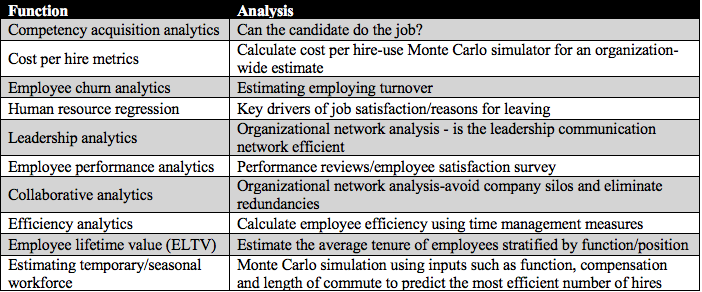Editor's note: Michael Lieberman is founder and president of Multivariate Solutions, a New York-based consulting firm. He can be reached at michael@mvsolution.com.
Today, the majority of human resource departments focus on reporting employee data. This doesn’t suffice in today’s data-driven economy. Human resource professionals need to analyze the vast amount of company data to gain tangible organizational insights and drive company acquisitions, optimize leadership communication, measure employee effectiveness and make crucial decisions with the aid of data-driven evidence.
Just as predictive analytics has maximized micro-target marketing, analytics are changing the human resource field. It enables the human resource department to:
- make better decisions using data;
- create a business case for human resource interventions;
- test the effectiveness of these interventions;
- measure and improve employee experience;
- quantify employee engagement; and
- optimize organizational development.
In this article I will be sharing several tips for those looking to maximize the insights gained by using human resource analytics.

1. Begin with the end in mind.
Whether you are seeking branding insights, the optimal price for a product or evaluating employee engagement, keep an eye on the prize. Envision three to five bullet points the analyst must deliver to the C-suite, be it the CMO or the CHRO, as it will be the only output they read.
This mentality will lead organizations to adopt more efficient analytical practices, build a culture of data-driven decisions and lead the human resource industry as a whole to habitually adopt analytical methods into their everyday function.
2. All analytics need human eyes.
In human resources, AI and machine learning are beginning to come to the top of the analytics hot topics. However powerful, these techniques still need human eyes to analyze and deliver the action plan. Moreover, these techniques do not always outperform older, tested methods that have been in use in the HR arena, such as the Caliper Profile or the Myers-Briggs Type Indicator.
3. Training for the future.
Any human resource professional entering the HR analytics field should learn basic statistics – the equivalent of an introduction to statistic class in university. You don’t need to become a professional statistician. Understand that correlation does not indicate causation. Be able to read a regression analysis output, a time series regression and the odds-ratio percentage chance of an employee leaving the firm. Understand what a measure of collaboration means along with basic predictive analytics.
An example is the output of a lifetime value model (ELTV), only the subject is not the value of a customer but the expected tenure of an employee based on models produced from past data collected by the corporation. For example, a new hire fills a position in which the ELTV estimates he will remain for five years. If the company is pleased with this employee, perhaps they can take measures to entice the employee to stay past the tenure estimation. Regression analysis using employee satisfaction data can indicate the most effective incentive.
Human resource analytics – listed
The analytics role in human resources is only one part of the human resource professional’s function. It is my opinion that there are only a finite number of analytic techniques that can be properly employed in the human resource analytics quiver. These form the core day-to-day analytics output. I highly recommend that the human resource analytics professional become familiar with the techniques on the table below and know when to employ them.
Table 1 includes the most common techniques existing in human resource analytics.

I recommend that companies move away from classic performance reviews. With modern data capture techniques, it is possible to analyze performance more comprehensively and with less focus on specific parts of a job that might cause employees to alter their behavior. The techniques, most of which are shown above, remove some of the politics of working in a large organization. It lessens the weight of the opinion of a single supervisor over an employee’s performance and leads to a feeling of job well-being and, usually, improved performance.
More efficient, more profitable
It is important to remember that people are people. Unlike with products where the analyst’s goal is to maximize sales, value or efficiency of distribution, HR analytics works to both enrich and enhance the professional lives of employees and make their respective enterprises more efficient and profitable. Everybody wins.
The techniques exist. Understand the goal of your function and then familiarize yourself with the technique. Do not depend too highly on a platform promising to be the magic bullet to solve all of your human resource needs. These can be effective tools, but they will only be as effective as the human resource practitioner who is using them. Platforms are a means to an end, not the end itself.
